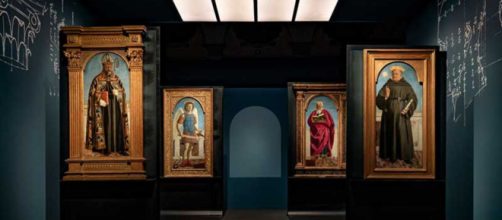Art scholarship has its place; it answers who and when questions about painting or sculpture. However, when limited only to such tombstone information, the artist's objectives get overlooked.
A recent example is the academic analysis of a multi-panel altarpiece by Renaissance painter Piero della Francesca. The panels, long separated and now reunited for the first time in 450 years, are showing at Milan's Poldi Pezzoli Museum.
The Associated Press captioned the scholarly study this way: "Milan exhibit sheds new light on Renaissance altarpiece, reuniting far-flung panels after centuries." Note that the artist doesn't even get a mention.
To the credit of ABC News, even though Piero della Francesca didn't make it into the headline, he appears in the first paragraph.
The altarpiece initially held 30 panels, but only eight have survived. Gathering them from treasure houses in Europe and the United States was a big deal. Scholars were understandably excited about this.
However, Piero's point of view, made clear in these panels, isn't touched on anywhere in the Associated Press report. Instead, you get the scholars' discovery of pink and blue paint fragments shaped like wings, made visible with infrared analysis of one of the existing panels.
The scholars believe these traces of pink and blue paint came from the central panel of the altarpiece, pointing to what the missing painting looked like.
The cognoscenti are understandably excited about this, too.
But again, Piero's intentions don't enter into their conversation. In the words of one of the scholars, Machtelt Brüggen Israëls, co-curator of the University of Amsterdam: "The research we have done have allowed us to reveal the biggest mystery that remained around this work."
And the mystery is?
Brüggen thinks the central panel depicts the coronation of the Virgin. Fellow scholar Nathaniel Silver, co-curator of the Isabella Stewart Gardner Museum, called the finding of the paint fragments "a huge ah-a!"
All this is notable, of course, but don't readers of this story need to know the artist's objective? Allow me.
Piero was intent on naturalism, down to bubbly river water under Christ's feet in his painting "The Baptism of Christ." Why naturalism?
It made spiritual figures real.
Reality was not in the picture before the Renaissance – in the Middle Ages – that stretched between the ancient world and the start of modernity. All eyes had turned from the secular to the celestial for a thousand years. Renaissance artists like Piero reset the relays.
Rather than heavenly harmony, the earthly variety became the model of the day. Piero studied ways to transform two-dimensional planes into three-dimensional panoramas using perspective.
Making Biblical figures believable
In "The Flagellation of Christ," Piero arranged his figures on a checkered floor like chess pieces, with the flagellation of a small and pale-colored Christ set in the background.
To add to the suggestion of near and far, the foreground figures – presumably Pontius Pilate and Herod – are enlarged. To convey his feelings about these men, Piero colored them darkly to represent their evil ways.
Yet, none of Piero's efforts made it into the scholars' discussion. By ignoring his art ideas in the altarpiece, the infrared discovery is reduced to find mislaid car keys.
Infra-red analysis of an artwork only speaks to what your eye sees. Without connecting the dots, you end up with minutia.
As Picasso famously said: "What do you think an artist is? An imbecile who only has eyes if he's a painter, ears if he's a musician, or a lyre in every chamber of his heart if he's a poet – or even, if he's a boxer, only some muscles?
Quite the contrary, he is at the same time a political being constantly alert to the horrifying, passionate or pleasing events in the world, shaping himself completely in their image."
The curators were so taken with their research. They missed the point Piero was making.


